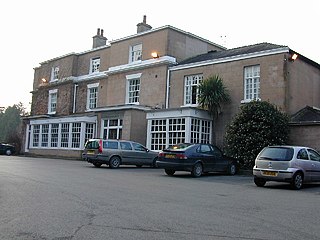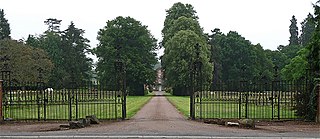
Hugh Lupus Grosvenor, 1st Duke of Westminster,, styled Viscount Belgrave between 1831 and 1845, Earl Grosvenor between 1845 and 1869, and known as The Marquess of Westminster between 1869 and 1874, was an English landowner, politician and racehorse owner. He inherited the estate of Eaton Hall in Cheshire and land in Mayfair and Belgravia, London, and spent much of his fortune in developing these properties. Although he was an MP from the age of 22, and then a member of the House of Lords, his main interests were not in politics, but rather in his estates, in horse racing, and in country pursuits. He developed the stud at Eaton Hall and achieved success in racing his horses, winning the Derby on four occasions.
Sir Piers Dutton was the lord of the manor of Dutton from 1527 until his death. He was involved in the closing of Norton Abbey during the Dissolution of the Monasteries in 1536. He started rebuilding Dutton Hall in 1539.

Sir Thomas Joseph de Trafford, 1st Baronet, was a member of a prominent family of English Roman Catholics. He served as commander of the Manchester and Salford Yeomanry at the time of the Peterloo Massacre. He was born at Croston Hall near Chorley, Lancashire, on 22 March 1778, son of John Trafford and Elizabeth Tempest, and was christened Thomas Joseph Trafford.

Markeaton Park is a large public park located in Markeaton, Derby, 207 acres in size. It attracts one million visitors a year, making it one of the most visited parks in the East Midlands. Markeaton Park is an important part of Derby history, which was sold to the Mundy family in 1516. The Mundy family gave Markeaton Park to Derby City Council in the early 20th century, who now provide facilities and events throughout the year.
Jodrell Hall is a country house near Jodrell Bank in the parish of Twemlow, in the county of Cheshire, England.
Richard Standish was an English politician who sat in the House of Commons in 1659 and 1660. He was a colonel in the Parliamentarian army in the English Civil War.

Chorlton Hall is a country house in the parish of Chorlton, Cheshire, England. It stands some 1.5 miles (2.4 km) northwest of Malpas. The house dates from the 17th century, with additions made in the second quarter of the 19th century. Its entrance front is pebbledashed and it stands on a stone plinth. The roof is slated. The house is in 2½ storeys plus cellars. Across the front are three bays, each with a gable, and with the central bay protruding. On the gables are ball finials. The porch has an ogee-arched entrance. The house is recorded in the National Heritage List for England as a designated Grade II listed building. A stable block and two cottages to the southeast of the house have also been designated at Grade II.

Hartford Manor is a former country house in the village of Hartford, Cheshire, England. Its age is uncertain; it was said to have been re-fronted in about 1820 for John Marshall, but the core of the building is earlier. It has since been altered and extended. During the 20th century the building was used an office. It one time it was used by North West Gas; as of 2011 it is the office of Holidaybreak. The house is constructed in yellow ashlar stone, and it has a hipped slated roof. Its front is symmetrical with two storeys and five bays. The central bay is slightly bowed, and contains a portico with two Doric columns and a flat entablature. It is recorded in the National Heritage List for England as a designated Grade II listed building. It is now used for office accommodation.

Hoole Hall is a former country house located to the north of Chester, Cheshire, England. It originated as a small house in about 1760, built for the Rev John Baldwin. After Rev Baldwin's death in 1793, the house passed to his eldest son, Thomas Baldwin, who then sold the house and surrounding land in 1800.

Middlewich Manor is a former manor house in Middlewich, Cheshire, England. It was originally constructed in brick in about 1800, and it was encased in ashlar in about 1840, when the porch was also built The bay windows were added in the 1870s. As of 2011, it is a residential care home. The house is constructed in yellow ashlar and is in two storeys. On its entrance front is a porch supported by four fluted Ionic columns. Along the top of the porch is a frieze and a cornice. On each side of the porch are two-storey canted bay windows. Between the stories is a band of Greek keys. A parapet runs along the top of the house, behind which is a low-pitched roof. On the garden front there are sash windows and a canted two-storey bay window to the right, and a wing with a stone oriel window and a pyramidal slated roof to the left. There is more decoration with bands of Greek keys on this front. The house is recorded in the National Heritage List for England as a designated Grade II listed building.

North Rode Manor is a country house standing to the north of the village of North Rode, Cheshire, England. The house was built between 1838 and 1840 for John Smith Daintry, a banker and silk manufacturer from Macclesfield, on the site of an earlier house that had been destroyed by fire. Alterations have been carried out since it was originally built. The house is constructed in stuccoed brick with ashlar dressings and slate roofs. It is in two storeys. The entrance front has five bays, the two on the left protruding forwards. The entrance porch dates from the 19th-century and is supported by paired Tuscan columns. To the right of this is a canted bay window. On the right side of the house is another canted bay window, and on the left side is a tower with a pyramidal roof. The house is recorded in the National Heritage List for England as a designated Grade II listed building. The authors of the Buildings of England series describe it a "sprawling white house in Regency Gothic".

Rowton Hall Hotel is a historic stately home, now run as a hotel in Rowton, Cheshire, England. The hall was originally built in the 14th century and was rebuilt in 1779 in the Georgian style. The Battle of Rowton Heath took place in the grounds in 1643. It contains the oak-panelled Langdale Restaurant.
Sir John Holcroft of Holcroft Hall, Culcheth, was a soldier, politician, and landowner of the Tudor period. He was returned twice as a member of the English parliament for Lancashire.

Henley Hall is a building of historical significance and is listed on the English Heritage Register. It was built in about 1610 by the Powys family and then substantially changed in 1772. Additions were again made in the late 19th century. It is a generally a three-storey building in brick with a slate roof. Flanking wings were added at both ends of the original linear building c. 1772 and further major extensions carried out in 1875 and 1907. The hall is surrounded by landscaped and formal gardens covering some 60 hectares. The hall itself is listed grade II* and the orangery, outbuildings, dovecote and Bitterley main gate are listed Grade II. It is situated 2.5 miles (4.0 km) northeast of Ludlow town centre, just off the A4117 road to Cleobury Mortimer. The Ledwyche Brook flows by the estate.

Soughton Hall is a Grade II* listed country house hotel in Sychdyn, Flintshire, Wales. Notable guests that have stayed include Luciano Pavarotti, Michael Jackson and King Juan Carlos I of Spain. William John Bankes inherited Soughton Hall in the 1815.

The National Communities Resource Centre (NCRC) is a British charity which was set up in 1991 to offer support and training to residents in low-income areas. It runs courses for tenants and community groups from its premises near Chester. Since 2020 it has been part of Regenda Group, a company which provides and operates affordable housing.

Southover Grange in Lewes, Sussex is a house of historical significance and is Grade II* listed on the English Heritage Register. It was built in 1572 by William Newton and owned by this family for the next three hundred years. After this it was the residence of many notable people until it was bought by the local Council in about 1945. Today it is owned by the East Sussex County Council. It now houses the Lewes Register Office which provides Marriage Ceremony Packages, civil partnerships and citizenship ceremonies. The gardens host events from local theatre to beer an gin festivals.

Lympstone Manor in Exmouth, England, is a building of historical significance and is Grade II listed on the English Heritage Register. It was mainly built in the 1760s around an older building which had been used as a farmhouse. At this time the owner was Charles Baring, a wealthy banker who had just been married. It was the residence of many notable people for the next two centuries. Today it is a hotel, restaurant and vineyard. The house has never held the Manorship of Lymstone, which instead has traditionally been associated with Nutwell Court.

Albrighton Hall near Shrewsbury, Shropshire, is a house which is Grade II* listed on the National Heritage List for England. It was built in 1630 for the Ireland family and remained in this family for the next five generations until 1804. It was then the home of several notable people until 1953. In the 1990s it was converted into a hotel.

Yeldersley Hall is a building of historical significance in Ashbourne, Derbyshire, England and is listed on the English Heritage Register. It was built in about 1800 by a wealthy landowner and was the residence of many notable people over the next two centuries. Today it is a venue for special events, particularly weddings.



















